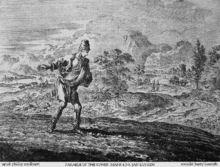Erhalt uns, Herr, bei deinem Wort, BWV 126

Erhalt uns, Herr, bei deinem Wort (Uphold us, Lord, within thy word), BWV 126, is a church cantata by Johann Sebastian Bach. He wrote it in 1725 in Leipzig for the Sunday Sexagesimae, the second Sunday before Ash Wednesday, and first performed it on 4 February 1725.
History and words
Bach wrote the chorale cantata in his second year in Leipzig for Sexagesimae and first performed it on 4 February 1725. This means that it was performed only two days after the cantata BWV 125 for the Purification of Mary on 2 February.[1] The prescribed readings for the day are 2 Corinthians 11Template:Bibleverse with invalid book:19 – 2 Corinthians 12Template:Bibleverse with invalid book:9, and Luke 8Template:Bibleverse with invalid book:4–15, the Parable of the Sower. The cantata is mainly based on the hymn Erhalt uns, Herr, bei deinem Wort of Martin Luther,[2] but also on other hymn stanzas, which frequently appeared together in hymnals of Bach's time; three stanzas of Luther's chorale, are followed by two stanzas of Justus Jonas, Luther's German version of Da pacem Domine (Give peace, Lord, 1531), and a stanza of Johann Walter paraphrasing 1 Tim 2Template:Bibleverse with invalid book:2 (1566).[3]
The result are seven stanzas:
- Erhalt uns, Herr, bei deinem Wort
- Beweis dein Macht, Herr Jesu Christ
- Gott Heilger Geist, du Tröster wert
- Ihr' Anschläg, Herr, zunichte mach
- So werden sie erkennen doch
- Verleih uns Frieden gnädiglich
- Gib unserm Fürsten und aller Obrigkeit
The unknown poet of the cantata text kept stanzas 1, 3, 6 and 7 unchanged, expanding 3 by recitative, and reworded 2, 4 and 5 for the respective movements of the cantata. The topic of both, the hymn and the gospel, is obviously God's word, but instead of relating more closely to the parable, the poet concentrates on a general request to God: keep his people faithful to his word, protect them from enemies and provide peace.[3]
Scoring and structure
The cantata is scored for alto, tenor, and bass soloists, a four-part choir, trumpet, two oboes, two violins, viola and basso continuo.[3]
- 1. Coro: Erhalt uns, Herr, bei deinem Wort
- 2. Aria (tenor): Sende deine Macht von oben
- 3. Recitativo e chorale (alto, tenor): Der Menschen Gunst und Macht wird wenig nützen – Gott Heiliger Geist, du Tröster wert
- 4. Aria (bass): Stürze zu Boden, schwülstige Stolze!
- 5. Recitativo (tenor): So wird dein Wort und Wahrheit offenbar
- 6. Chorale: Verleih uns Frieden gnädiglich
Music
A characteristic feature of the opening chorus is a four-note trumpet signal, which is derived from the beginning of the chorale melody, as if to repeat the words "Erhalt uns, Herr" (Uphold us, Lord) again and again.[4] The motif consists of the three notes of the A minor chord in the sequence A C A E, with the higher notes on the stressed syllables, the highest one on "Herr". The cantus firmus of the chorale[2] is sung by the soprano, the other voices sing in imitation, embedded in an independent concerto of the orchestra.[3]
The first aria is a prayer, intensified by two oboes. In the middle section the words "erfreuen" (delight) and "zerstreuen" (scatter) are illustrated by fast runs in the tenor. The second aria, movement 4, is dramatic, especially in the restless continuo. John Eliot Gardiner quotes W. G. Whittaker: Bach’s "righteous indignation at the enemies of his faith was never expressed more fiercely than in this aria".[4] Movement 3 presents the recitative in the alternating voices alto and tenor, but the ornamented chorale as a duet. The chorale melody switches also, given to the voice which enters, whereas the other one continues its recitative by accompanying material. Movement 6 combines the two stanzas from different chorales in a four-part setting.[3]
Recordings
- J.S. Bach: Cantatas BWV 126 & BWV 149, Wolfgang Gönnenwein, Süddeutscher Madrigalchor, Consortium Musicum, Janet Baker, Theo Altmeyer, Hans Sotin, EMI 1967
- Bach Cantatas Vol. 2 - Easter, Karl Richter, Münchener Bach-Chor, Münchener Bach-Orchester, Anna Reynolds, Peter Schreier, Theo Adam, Archiv Produktion 1974
- Die Bach Kantate Vol. 27, Helmuth Rilling, Gächinger Kantorei, Bach-Collegium Stuttgart, Helen Watts, Adalbert Kraus, Wolfgang Schöne, Hänssler 1980
- J.S. Bach: Das Kantatenwerk - Sacred Cantatas Vol. 5, Nikolaus Harnoncourt, Tölzer Knabenchor, Collegium Vocale Gent, Concentus Musicus Wien, Paul Esswood, Kurt Equiluz, Thomas Thomaschke, Teldec 1980
- Bach Cantatas Vol. 20: Naarden / Southwell, John Eliot Gardiner, Monteverdi Choir, English Baroque Soloists, Robin Tyson, James Gilchrist, Stephan Loges, Soli Deo Gloria 2000
- J.S. Bach: Complete Cantatas Vol. 14, Ton Koopman, Amsterdam Baroque Orchestra & Choir, Franziska Gottwald, Paul Agnew, Klaus Mertens, Antoine Marchand 2000
- J.S. Bach: Cantatas Vol. 34, conductor Masaaki Suzuki, Bach Collegium Japan, Robin Blaze, Gerd Türk, Peter Kooy, BIS 2005
References
- ^ Julian Mincham (2010). "Chapter 39 BWV 126 Erhalt uns, Herr, bei deinem Wort". jsbachcantatas.com. Retrieved 19 February 2011.
- ^ a b "XXXIII.: Erhalt uns, Herr, bei deinem Wort. Lord, keep us in Thy Word and Work. - Martin Luther, The Hymns of Martin Luther 1884". libertyfund.org. 2011. Retrieved 20 February 2011.
- ^ a b c d e Alfred Dürr. 1971. "Die Kantaten von Johann Sebastian Bach", Bärenreiter (in German)
- ^ a b John Eliot Gardiner (2009). "Cantatas for Sexagesima / Southwell Minster" (PDF). solideogloria.co.uk. p. 8. Retrieved 30 January 2011.
External links
- Free scores by Cantatas, BWV 121–130 at the International Music Score Library Project (IMSLP)
- Cantata BWV 126 Erhalt uns, Herr, bei deinem Wort on bach-cantatas.com
- German text and English translation, Emmanuel Music
- Erhalt uns, Herr, bei deinem Wort on the Bach website (in German)
- BWV 126 Erhalt uns, Herr, bei deinem Wort on uvm.edu
